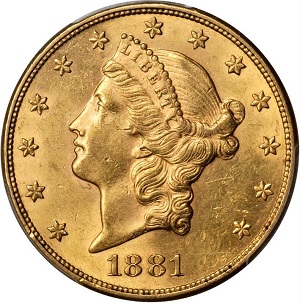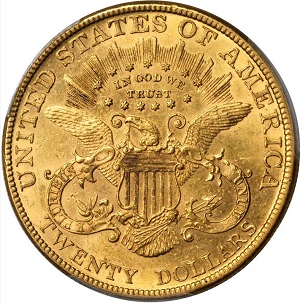1881 Coronet $20 Double Eagle
The year 1881 began a streak of extremely low mintage for Coronet $20 double eagles from the Philadelphia Mint, continuing through 1887. The 1881 mintage of just 2,199 business strikes was the high-water mark during that seven year stretch. The cause for such microscopic outputs can be traced back to the Civil War years of 1861-65.(1)
Late in 1861, as fears of a long, protracted war took hold, the United States suspended specie (i.e., gold and silver) payments in redemption of currency notes. This was to protect the government’s precious metal reserves during wartime.(2)
Early in 1862, the U.S. issued legal tender notes called Greenbacks, backed only by the credibility of the federal government. Their value fluctuated with the North’s fortunes of war. At one point, the Greenbacks were worth only 35 cents of a dollar’s worth of gold but by the end of the war, they were worth 78 cents. In all, a total of $431 million in Greenbacks were distributed.(3)
As the Reconstruction era unfolded, bitter debates raged over the continued presence of the Greenbacks in the U.S. economy. In 1875, Congress adopted the Specie Resumption Act, ordering the Treasury Secretary to redeem in gold all Greenbacks presented to the Treasury on or after January 1, 1879.
In anticipation of large-scale Greenback redemption, the Treasury Department accumulated additional gold coin reserves.(4) Mintage of smaller gold coin denominations plunged in favor of large gold denominations, most especially for $20 double eagles.(5)
As 1879 approached, Greenbacks achieved full parity with gold. That is, they became worth their full face value in gold. Under these circumstances, most Greenback owners unexpectedly did not bother to redeem them.
Complaints flowed into the Treasury about the excess of double eagles – they were too large for everyday commerce – and the lack of smaller gold coins.
Responding to criticism, the Treasury decreased double eagle output nationally while implementing a policy to expand production of $5 and $10 gold coins.
The Philadelphia Mint double eagle mintages of the late 1870’s through mid-1880’s were indicative of the fluid events described above. Here are the Philadelphia Mint double eagle mintages for this time:
- 1878: 543,625
- 1879: 207,600
- 1880: 51,420
- 1881: 2,199
- 1882: 571
- 1883: (Proof only, 92)
- 1884: (Proof only, 71)
- 1885: 751
- 1886: 1,000
- 1887: (Proof only, 121)
- 1888: 226,161
And so, the 1881 double eagle was the first effort in a seven-year period to increase the number of half eagles and eagles in circulation, mostly at the expense of the double eagle.
Also, the Philly Mint was charged with high volume production of the Morgan dollar, under the weight of the Bland-Allison Act, further reducing resources for double eagle coinage.(6)
The 1881 double eagle is a rarity in all grades. There are an estimated 67 examples that have survived to this day.(7) With such a small supply, it's not surprising to see advanced collectors compete aggressively on the seldom occasion when an example appears in the marketplace.
| Estimated survivors in all grades: 67 ?
The survivor estimate from PCGS represents an average of one or more experts' opinions as to how many examples survive of a particular coin in all grades. Survival estimates include coins that are raw, certified by PCGS, and certified by other grading services. Learn more at PCGS. |
| PCGS Rarity Scale: 8.3 ?
The 'PCGS CoinFacts Rarity Scale' assesses the relative rarity of all U.S. coins, based on estimated surviving examples. The scale runs from 1.0 to 10.0. The higher the number, the rarer the coin.
Learn more at PCGS. |
| Click HERE to check for availability on eBay** |
Preview of eBay selection (this one is a toughie!):
 |
 |
| Trendline Avg = 16.62 | GOOD |
Historic Value Trend Charts:
| Last updated 10-9-24 | Return to Key Date Coin List | |
| Compare to Common Date Coin of Same Type | ||
|
|
||
| Download Charts to Your Computer | ||
Sources
1. Heritage Auctions. 1881 $20 MS61. Aug 2015 Auction.
2. Wikipedia. Specie Payment Resumption Act.
3. Todd, Lewis P. and Curti, Merle. Rise of the American Nation, 3rd ed. New York, NY: Harcourt Brace Jovanovich, Inc., 1972.
4. Taxay, Don. The U.S. Mint and Coinage. New York, NY: Sanford J. Durst Numismatic Publications, 1966.
5. Heritage Auctions. 1881 $20 MS61. Aug 2015 Auction.
6. Heritage Auctions. 1881 $20 MS61. Apr 2014 Auction.
7. PCGS. 1881 $20 (Regular Strike).
**Many very fine coin dealers sell on eBay. At any point in time, there may be over one million search results for United States coins. This includes quite a few of the recommendations on our Key Date Coin List.
If you’re thinking about purchasing a rare coin, eBay is certainly worth a look. For your convenience, the links from this site to eBay are coded to bring up only coins certified by PCGS and NGC.
As is always, always the case, never buy a valuable coin from a seller whose trustworthiness cannot be verified. Learn more about this at our chapter Best Places to Buy Coins, which also has a section on doing business on eBay.
In the interest of full disclosure, Rare Coins 101 receives a small commission anytime someone connects to eBay from this site and purchases something.
Coin images by Stack's Bowers Galleries.


